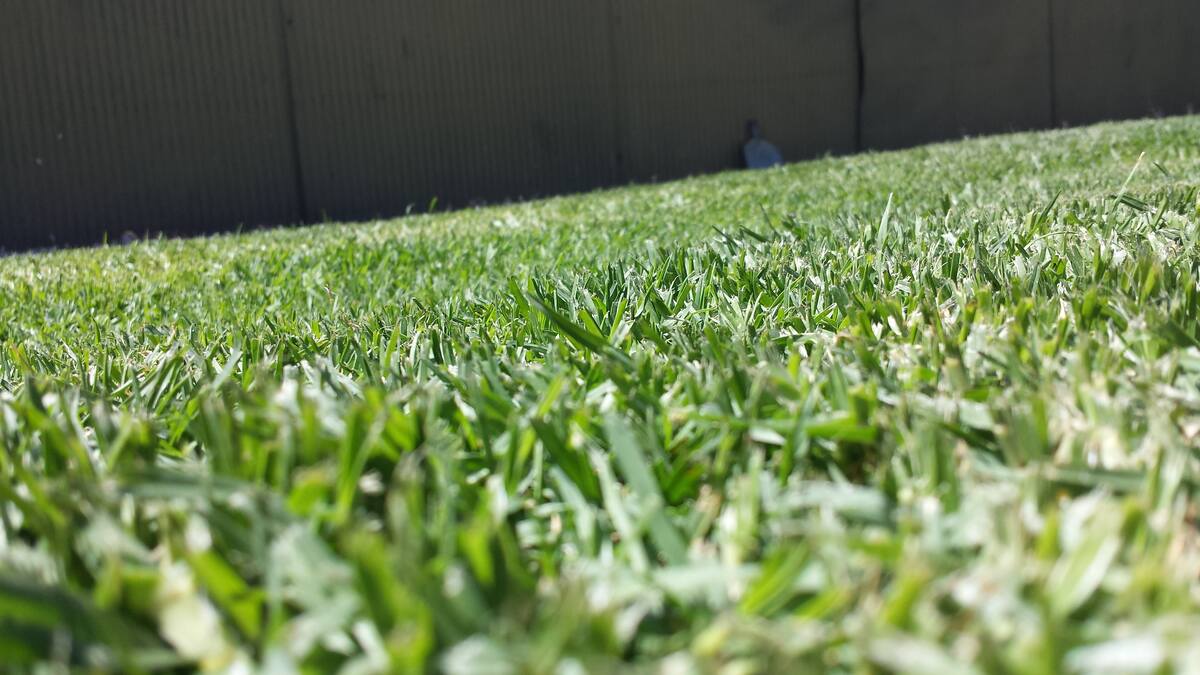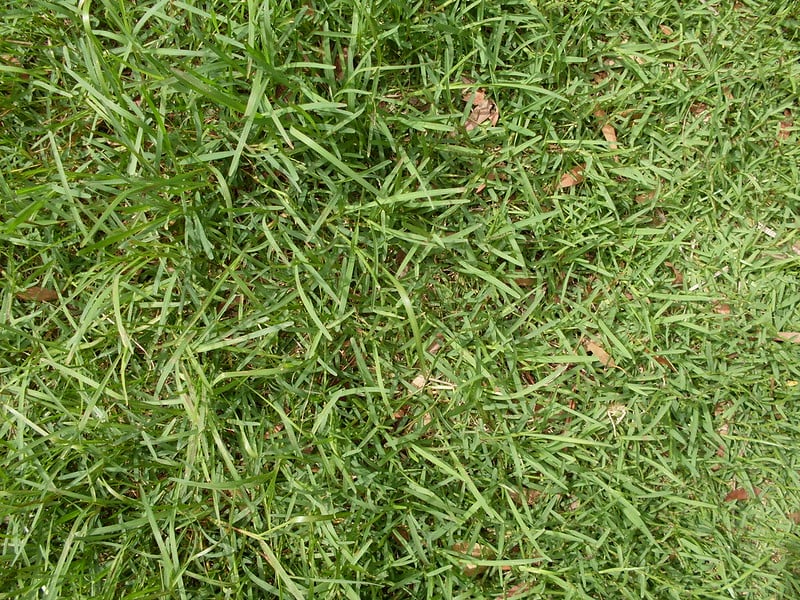
St. Augustinegrass is a southern favorite, popular for its thick carpeted appearance and shade tolerance. But if chinch bugs, root rot, or mole crickets are dragging down your curb appeal, what can you do? If you’re unsure how to care for St. Augustinegrass, here are some tips to help your lawn look its best.
St. Augustinegrass at a Glance
St. Augustinegrass (Stenotaphrum secundatum) is a high-maintenance, warm-season turf grass growing in lawns across the southern U.S. Popular in Texas and Florida, this perennial is recognizable by its dense carpet-like sod, broadleaf blades, and rich green color. St. Augustine is referred to as buffalo grass in Australia, though, don’t confuse it with the other buffalo grass (Bouteloua dactyloides), the North American prairie grass.
St. Augustinegrass has three main parts: the roots, stolons (aka runners), and broad flat blades. St. Augustine doesn’t have rhizomes like some other grasses.
St. Augustine thrives in full sun and partial shade, and its tolerance to salt makes it adaptable to coastal regions (or backyards with saltwater pools). It also tolerates moderate foot traffic.
How to Maintain St. Augustinegrass
Watering Requirements
St. Augustinegrass is highly drought-resistant. Like most established lawns, this grass type needs about 1 inch of water per week to survive.
How often should I water my lawn?
If your St. Augustine lawn isn’t getting enough water from rain, then water your St. Augustine lawn twice a week. It’s healthier for your turfgrass to receive water less often but for prolonged soakings than to water frequently and for short periods.
However, pay attention to your soil type. Sandy soils and clay-heavy soils hold water differently. Clay soils take a while to absorb the water, so you may need to use a smaller volume of water and take breaks in between as you water. Otherwise, the water won’t drain and will escape the yard as runoff.
Sandy soils filter water faster than clay soils, which means they take less time to water but may need more frequent irrigation than clay soils.
How can I tell if my lawn needs watering?
A simple way to know if your grass is getting enough water is to walk on it. If the blades spring back into place after you step on them, your grass is hydrated and healthy. If the blades are curling or turning a dull color, it’s time to water.
When is the best time to water my lawn?
Watering in the early morning is ideal. Watering sometime between sunrise and 10 a.m. is perfect because it allows the water to saturate the ground before the sun and wind can evaporate it.
Avoid watering your lawn in the evening. Watering at night or in the evening risks allowing water to sit on your grass too long, causing rot, fungal infections, and harmful pests.
Mowing

Mowing your lawn keeps your grass looking great and promotes healthy growth. It also chases off pests by altering their habitat. Most pests prefer long grass because it offers ample places to hide. Mowing chases off ants, ticks, grasshoppers, and other nuisance pests.
St. Augustine should be between 2.5 and 3 inches in height. Cutting this grass too short invites weeds and disease. Plus, the sun can fry this grass if kept too short.
Begin your mowing routine once your St. Augustinegrass gets its spring green color and the grass blades reach a mowing height above 3 inches, typically between 3.75 and 4.5 inches. St. Augustine’s growing season typically ends in fall which is when you can store away the mower.
Remember the rule of one-third when mowing: Don’t cut more than a third of the grass’ height at once, or you risk stressing your turf.
Avoid cutting your lawn with dull blades. Dull blades lead to:
- A ragged appearance
- Unsightly yellow hue
- Increased susceptibility to lawn diseases
- Damaged turf (from being pulled and ripped)
Fertilizer
If you want to enhance your St. Augustine lawn’s health, you may be interested in adding some fertilizer to your yard.
It’s a good idea to test your soil before adding any fertilizer. Playing a guessing game with your fertilizer applications can result in dead grass or a damaged lawn. Soil test kits are available at your local hardware store, or for a more accurate assessment, contact your local cooperative extension for instructions on how to prepare a soil sample for laboratory testing.
The best time of year to fertilize warm-season grass like St. Augustinegrass is in late spring or early summer. Applying fertilizer once a year is usually sufficient for a healthy, established lawn.
Thatch Removal
Compared to other sod grasses, St. Augustinegrass is not particularly prone to thatch buildup. However, if your lawn requires thatch removal, the best time to do so is in the late spring or early summer as your lawn begins to actively grow.
Thatch is the layer of organic material between the soil and your grass. Some thatch is normal –– a healthy layer of thatch is less than ½-inch thick. This layer of organic material protects your lawn from temperature extremes while helping the turf hold moisture.
But if your thatch exceeds ½-inch thick, your grass won’t receive the water it needs to develop. The thick thatch will also become a desirable incubator for pests and diseases.
Remove thatch with a dethatching machine. You can rent dethatchers from your local home improvement store or hire a local pro for the job.
Aeration
Heavy rainfall, parked vehicles, and frequent foot traffic can all lead to compacted soil. Aeration relieves compacted soils by removing plugs of soil from the ground, allowing water, air, and nutrients to reach the roots.
Aerate your St. Augustine lawn in the early summer when the grass proliferates. Clay lawns typically require annual aeration, while sandy soils usually only need aeration once every two to three years (to see what other factors affect frequency, check out When and How Often Should You Aerate Your Lawn?).
To test whether your lawn requires aeration, try to insert a screwdriver into the ground. If the screwdriver doesn’t budge, then the soil is likely compacted. But if the screwdriver enters the soil with ease, then there’s no need for aeration.
Disease Control
If your St. Augustinegrass still looks brown and sick despite your efforts to mow, dethatch, aerate, fertilize, and water, you may be dealing with a disease or infection, such as;
- Gray leaf spot: Gray leaf spot is a fungal pathogen that attacks the leaf blades of St. Augustine grasses. Fungicides are an effective treatment for gray leaf spot.
- Pythium root rot: Lawns with poor drainage are susceptible to root rot. Signs of root rot include wilting, stunted growth, and crown rot. Check your irrigation setup or relieve soil compaction to allow for proper drainage.
- Take-all root rot: This fungal infection is less receptive to anti-fungal treatments. It lives in the soil and can be hard to treat. Try switching up your watering routine and improve your lawn care maintenance. Opt for infrequent heavy soakings when watering rather than frequent shallow watering.
Pest Control
Your St. Augustine lawn can become home to pests. Identifying and understanding these common pests will help you to get rid of them:
- Chinch bugs: Chinch bugs eat the sap of St Augustinegrass, then inject a toxin that prevents water movement in the plant. Insecticides are available at your local hardware store.
- White grubs: These grubs feast on your grasses’ root system, causing turf separation and unsightly brown patches in your yard. Carbaryl and trichlorfon are common ingredients used to eradicate grubs in each lifecycle.
- Mole crickets: Like grubs, mole crickets eat grass roots and rhizomes. Try flushing them out with soapy water.
Weed Control
Weeds leach valuable nutrients from nearby plants and greedily soak up water, affecting your grass’s growth. Some weeds harbor unwanted pests and invite disease.
Although St. Augustine is a thick turf grass that chokes out most weeds, crabgrass and other weeds might occasionally cramp your style. Herbicides are a quick fix for an intrusive weed problem. Homeowners have their choice of pre-emergent and post-emergent herbicides.
Pre-emergent herbicides are used as a preventative treatment before weeds develop. These chemicals inhibit the growth of root cells in potential weeds, stopping them before they develop.
Post-emergent herbicides tackle weeds that have already germinated. Post-emergent herbicides knock out weeds by infecting the stalk, which kills the roots.
Skip Overseeding
Your neighbor might overseed their bermudagrass lawn, but overseeding is not recommended for St. Augustinegrass. Because it grows as a thick carpet, grass seeds won’t reach the ground. To ensure the seeds get to the dirt, you’d need to scalp the grass; however, scalping St. Augustinegrass can ruin it.
Additionally, St. Augustine produces fewer seeds than other grasses, so its seeds are not available for commercial use.
FAQ About St. Augustinegrass
Yes, high levels of nitrogen in fertilizer can burn your lawn. Fertilizer burn scorches the grass blades. Signs of fertilizer burn include grass discoloration and root damage.
St. Augustine will spread independently, but you can speed up the spread with sod and plugs from your local garden center.
Call a LawnStarter Lawn Care Pro
As you can see, St. Augustine is a hearty, high-maintenance turfgrass. If all that lawn maintenance becomes a chore, there’s no shame in hiring a pro. Hire a lawn care pro and enjoy your lush St. Augustine lawn.
Main Image Credit: Luxure / Flickr / CC BY 3.0 AU